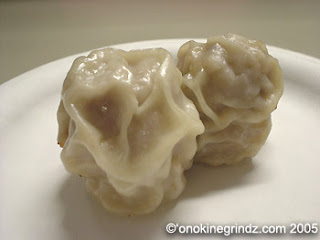Pork hash and Pepeiao are both Hawaiian foods that were brought in to work to celebrate the bar passers (Hawaii bar passers found out today) at the ICA. The judicial assistants also brought us all “Congratulations” balloons that were put on our desk in the morning. Very nice.
The best part of the celebration, though, was all the food that one of the judicial assistants brought in. In addition to Manapua, she also brought in Pork Hash and Pepeiao. This time it was from a different place, though, I’m not exactly sure where.
First of all, I found out that both dishes fall within the category of “Dim Sum.” Now, the easiest way to describe dim sum is that it’s the asian version of tapas. However, unlike tapas, dim sum is hearty and filling and not ridiculously and unreasonably overpriced. A dim sum is a Chinese-inspired meat dumpling-style snack food. The dish normally consists of a couple large balls of pork or other meat, cabbage and flavorings, encased in a wrapper similar to that of a more traditional dumpling. They are usually deep-fried or steamed, but can be barbecued. Dim sums differ from typical Chinese dumplings in that they are often much larger, have a thicker skin and are shaped more robustly. Traditional dim sum includes various types of steamed buns such as cha siu bau, dumplings and rice noodle rolls (cheong fun), which contain a range of ingredients, including beef, chicken, pork, prawns and vegetarian options.
Pork hash is one type of dim sum (think potsticker). They are bite size balls of delicious that I highly recommend. Also, like manapua, you could get them at 7-Eleven if you were so inclined. Although I have now mentioned two things you could get at 7-Eleven, there are tons of bakeries in Chinatown that are much better.
Growing wild on logs of the Koa and Kukui trees in Hawaii, the mushroom Auricularia cornea is known by the locals as Pepeiao which in Hawaiian means “ear.” This popular mushroom is included as part of the regional culinary culture primarily because of the population of Asians living in Hawaii. When I ate it, I had no idea it was a mushroom. It was wrapped in a weird, translucent type of noodle. It was also mixed with pork, which probably masked a lot of the flavor. Either way, it was really good and I would also highly recommend it.

Hi! Do you know the origin of the pepeiao and pork hash? Are they old dishes in the Hawaiian culture or is it a more recent influence from China and the chinise immigrants? Best Regards /Jonas
ReplyDelete